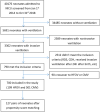HFOV vs CMV for neonates with moderate-to-severe perinatal onset acute respiratory distress syndrome (NARDS): a propensity score analysis
- PMID: 33638098
- PMCID: PMC7910198
- DOI: 10.1007/s00431-021-03953-z
HFOV vs CMV for neonates with moderate-to-severe perinatal onset acute respiratory distress syndrome (NARDS): a propensity score analysis
Abstract
This study aimed to evaluate whether high-frequency oscillatory ventilation (HFOV) could reduce mortality and the incidence of bronchopulmonary dysplasia (BPD) of perinatal-onset neonatal acute respiratory distress syndrome (NARDS) compared with conventional mechanical ventilation (CMV). Medical records were collected and retrospectively analyzed. Among the 700 neonates with NARDS who needed invasive ventilation, 501 (71.6%) received CMV, while 199 (28.4%) received HFOV. One-to-one propensity score matching (127:127) was used to match the baseline characteristics of patients who received CMV and HFOV. The results showed that birth weight and oxygenation index (OI) were independently associated with mortality in the multivariate logistic regression. No significant differences were observed in mortality or the incidence of BPD between the two groups. The incidence of intraventricular hemorrhage (IVH) and ventilation-free days were significantly lower in the HFOV group than in the CMV group (3.9 vs 11.80%, p=0.02; 15.226 vs 20.967 days, p=0.01). There were no significant differences between the two groups regarding other secondary outcomes.Conclusion: HFOV was associated with a decreased incidence of IVH in infants with NARDS compared with CMV. However, there were significantly more VFDs in the CMV group than in the HFOV group, and HFOV did not appear to be superior to CMV in decreasing the mortality and incidence of BPD in infants with NARDS. What is Known: • The diagnostic criteria of neonatal acute respiratory distress syndrome (Montreux criteria) were established in 2017. • To date, studies comparing high-frequency oscillatory ventilation and conventional mechanical ventilation in the treatment of neonatal acute respiratory distress syndrome are insufficient. What is New: • High-frequency oscillatory ventilation did not appear to be superior to conventional mechanical ventilation in decreasing the mortality and incidence of bronchopulmonary dysplasia in infants with moderate-to-severe perinatal-onset neonatal acute respiratory distress syndrome. • High-frequency oscillatory ventilation was associated with a decreased incidence of intraventricular hemorrhage in infants with moderate-to-severe perinatal-onset acute respiratory distress syndrome compared with conventional mechanical ventilation.
Keywords: CMV; HFOV; NARDS; Neonates.
Conflict of interest statement
The authors declare no competing interest.
Similar articles
-
Clinical characteristics and outcomes in neonates with perinatal acute respiratory distress syndrome in China: A national, multicentre, cross-sectional study.EClinicalMedicine. 2022 Nov 12;55:101739. doi: 10.1016/j.eclinm.2022.101739. eCollection 2023 Jan. EClinicalMedicine. 2022. PMID: 36386029 Free PMC article.
-
The Effects of HFOV-VG vs HFOV on Bronchopulmonary Dysplasia and Neurobehavioral Development in Preterm Infants with Perinatal Acute Respiratory Distress Syndrome.Int J Gen Med. 2025 Aug 24;18:4695-4708. doi: 10.2147/IJGM.S534091. eCollection 2025. Int J Gen Med. 2025. PMID: 40894443 Free PMC article.
-
Comparison of high-frequency oscillatory ventilation and conventional mechanical ventilation in pediatric respiratory failure.JAMA Pediatr. 2014 Mar;168(3):243-9. doi: 10.1001/jamapediatrics.2013.4463. JAMA Pediatr. 2014. PMID: 24445980
-
Elective high-frequency oscillatory ventilation versus conventional ventilation for acute pulmonary dysfunction in preterm infants.Neonatology. 2013;103(1):7-8; discussion 8-9. doi: 10.1159/000338553. Epub 2012 Aug 30. Neonatology. 2013. PMID: 23037971 Review.
-
Elective high frequency oscillatory ventilation versus conventional mechanical ventilation on the chronic lung disease or death in preterm infants administered surfactant: a systematic review and meta-analysis.J Perinatol. 2025 Jan;45(1):77-84. doi: 10.1038/s41372-024-02185-x. Epub 2024 Dec 2. J Perinatol. 2025. PMID: 39623024
Cited by
-
The perinatal period should be considered in neonatal acute respiratory distress syndrome: comparison of the Montreux definition vs. the second pediatric acute lung injury consensus conference definition.Front Pediatr. 2023 Sep 28;11:1216073. doi: 10.3389/fped.2023.1216073. eCollection 2023. Front Pediatr. 2023. PMID: 37842021 Free PMC article.
-
Endotracheal Surfactant and Budesonide Combination Therapy in Neonatal Acute Respiratory Distress Syndrome due to Late-Onset Sepsis.Arch Iran Med. 2024 Oct 1;27(10):573-579. doi: 10.34172/aim.31725. Epub 2024 Oct 1. Arch Iran Med. 2024. PMID: 39492564 Free PMC article.
-
Dynamic Monitoring of Serum Protein in Acute Respiratory Distress Syndrome Based on Artificial Neural Network.Comput Math Methods Med. 2022 Oct 17;2022:3542942. doi: 10.1155/2022/3542942. eCollection 2022. Comput Math Methods Med. 2022. PMID: 36299681 Free PMC article.
-
Risk factors for air leakage during invasive mechanical ventilation in pediatric intensive care units.Eur J Med Res. 2022 Oct 28;27(1):218. doi: 10.1186/s40001-022-00858-x. Eur J Med Res. 2022. PMID: 36307834 Free PMC article.
-
Safety and efficacy of a novel double-lumen tracheal tube in neonates with RDS: A prospective cohort study.Front Pediatr. 2022 Dec 5;10:1032044. doi: 10.3389/fped.2022.1032044. eCollection 2022. Front Pediatr. 2022. PMID: 36545664 Free PMC article.
References
-
- Lee SH, Choi CW, Oh YK, Kim BI. Atypical acute respiratory disorder in late preterm and term newborn infants. J Matern Fetal Neonatal Med. 2016;29(9):1430–1434. - PubMed
-
- Guo YX, Wang ZN, Li YT, Pan L, Yang LF, Hu Y, Sun YY, Cai LM, Chen Z. High-frequency oscillatory ventilation is an effective treatment for severe pediatric acute respiratory distress syndrome with refractory hypoxemia. Ther Clin Risk Manag. 2016;12:1563–1571. doi: 10.2147/TCRM.S115884. - DOI - PMC - PubMed
MeSH terms
Grants and funding
LinkOut - more resources
Full Text Sources
Other Literature Sources


